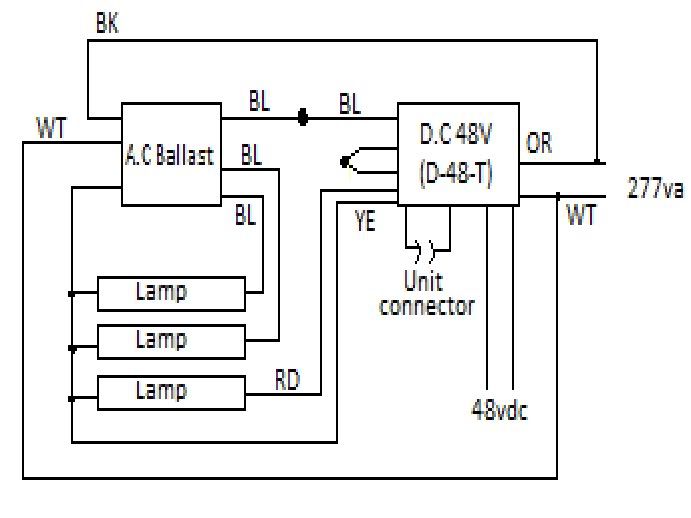Twoskinsoneman
Senior Member
- Location
- West Virginia, USA NEC: 2020
- Occupation
- Facility Senior Electrician
Sorry about the crudeness of this drawing I made it with Paint.
Had a fixture that is dual fed 277vac and 48vdc. The 48vdc was not functioning. (Power off 277 circuit and light goes out). Changed the 48vdc ballast (inverter) and it was fixed. But I now have a couple of questions.
#1 How exactly does the set up below work? Mainly does the 48vdc ballast feed the lamps by itself or does it work with the AC ballast to power the lamps. If your AC ballast failed would the 48vdc ballast still power the lamps? the reason I ask is because there is a similar fixture with an issue but it does not power on at all. I was told it was relamped and no-fix. Does this indicate both ballast are bad or can a failed AC ballast cause the problem?
#2 What is the unit connector for? The installation instructions state "Do not mate connector until installation is complete and AC power is supplied." In the cautionary section the instructions state "To prevent electrical shock do not mate connector until installation is complete and AC power is supplied to the unit." When I replaced the 48vdc ballast to fix the first fixture I noticed that the original installer never connected the unit connector at all...

Thanks as always.
Had a fixture that is dual fed 277vac and 48vdc. The 48vdc was not functioning. (Power off 277 circuit and light goes out). Changed the 48vdc ballast (inverter) and it was fixed. But I now have a couple of questions.
#1 How exactly does the set up below work? Mainly does the 48vdc ballast feed the lamps by itself or does it work with the AC ballast to power the lamps. If your AC ballast failed would the 48vdc ballast still power the lamps? the reason I ask is because there is a similar fixture with an issue but it does not power on at all. I was told it was relamped and no-fix. Does this indicate both ballast are bad or can a failed AC ballast cause the problem?
#2 What is the unit connector for? The installation instructions state "Do not mate connector until installation is complete and AC power is supplied." In the cautionary section the instructions state "To prevent electrical shock do not mate connector until installation is complete and AC power is supplied to the unit." When I replaced the 48vdc ballast to fix the first fixture I noticed that the original installer never connected the unit connector at all...

Thanks as always.
